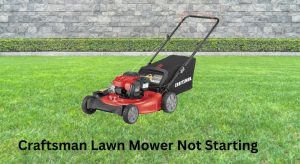You push the handle, pull the cord, and your yard stares back at you. If your Craftsman M230 lawn mower is not starting, you’re not alone—and you don’t need a new mower yet. The quickest fix? Check the fuel and spark: replace old gas with fresh unleaded 87+ octane, clean or replace the spark plug (Champion RJ19LM or equivalent), and ensure the safety bail is fully engaged. These three steps solve most no-start issues fast.
In this guide, you’ll get a complete troubleshooting blueprint for the Craftsman M230—including common causes, step-by-step fixes, maintenance tips, and when to call a pro. Follow along, and by the end you’ll have your mower running reliably again.
Common Causes of a Craftsman M230 Not Starting

- Stale or contaminated fuel (over 30 days old or ethanol gumming)
- Clogged carburetor or main jet
- Dirty or faulty spark plug
- Safety bail/engine brake not engaged or cable out of adjustment
- Air filter clogged or soaked with oil
- Flooded engine from repeated priming
- Faulty ignition coil (no spark)
- Blocked fuel line or bad fuel cap vent
- Low engine oil triggering shutoff (models with sensor)
- Blade obstruction or flywheel key sheared after impact
How to Fix a Craftsman M230 Not Starting

Work through these methods from simplest to more advanced. Plan 10–60 minutes depending on the step.
Method 1: Quick Checks and Fresh Fuel
Diagnosing the Issue
If the mower hasn’t run this season or gas is older than 30–60 days, suspect fuel. Ethanol-blended gas deteriorates quickly, causing hard starts.
Fix Steps
1) Safety first:
– Move to a flat, ventilated area.
– Disconnect the spark plug wire before any hands-on work.
2) Verify the safety bail:
– Squeeze the operator presence control (bail bar) firmly to the handle while starting. If the cable is slack, adjust the cable at the handle bracket until the engine brake fully releases.
3) Replace old fuel:
– Use a siphon to remove old gas from the tank.
– Add fresh unleaded 87+ octane fuel. For best results, use ethanol-free or add fuel stabilizer (per label).
4) Prime and start:
– If your M230 has a primer bulb, press it 3–5 times until you see fuel in the line or feel resistance. Do not over-prime.
– Pull the starter cord briskly with the bail engaged.
Testing
If it starts and runs smoothly, you’ve solved it. If not, proceed.
Method 2: Check and Service the Spark Plug
Time: 10–15 minutes
Part: Champion RJ19LM or NGK BPR6ES equivalent (verify in manual)
Diagnosing the Issue
A fouled or worn plug causes weak spark and no start.
Fix Steps
1) Remove the plug:
– Disconnect the spark plug boot.
– Use a 13/16″ spark plug socket to remove the plug.
2) Inspect:
– Wet with fuel? Engine flooded.
– Black and sooty? Running rich/clogged air filter.
– White and crusty? Running lean/air leak.
3) Clean or replace:
– If lightly fouled, clean with a wire brush and brake cleaner, then dry.
– Set gap to 0.030 in (0.76 mm).
– Replace if the electrode is worn or cracked.
4) Reinstall:
– Thread by hand, then tighten snugly (about 1/8–1/4 turn past finger tight with a socket).
5) Spark check (optional):
– Reconnect the boot to the removed plug.
– Ground the plug threads to the engine block.
– Pull the cord: look for a strong blue spark. No spark? See Method 5 (ignition coil).
Testing
Reconnect the plug, prime 3 times, engage the bail, and pull to start.
Method 3: Fix a Flooded Engine
Time: 5–10 minutes
Diagnosing the Issue
Repeated priming or many failed pulls can flood the cylinder. You’ll smell fuel and the plug will be wet.
Fix Steps
1) Remove the spark plug and dry it.
2) Turn off fuel (if your model has a shutoff). If not, avoid pressing the primer.
3) Open the choke (if manual) or hold throttle open (if applicable).
4) Pull the starter 6–10 times to clear fuel from the cylinder.
5) Reinstall the dry plug and try starting with minimal or no priming.
Testing
Engine should sputter and catch. If it stalls, go to air filter and carb steps.
Method 4: Air Filter and Intake Check
Time: 10 minutes
Diagnosing the Issue
A clogged filter chokes airflow, causing rich mixture and no start.
Fix Steps
1) Open the air filter housing (usually one or two clips/screws).
2) Inspect:
– Paper filter: Tap gently to remove dust. If oil-soaked or heavily dirty, replace.
– Foam pre-filter (if present): Wash with mild detergent, rinse, air dry completely, then lightly oil and squeeze out excess.
3) Reassemble and ensure the cover seals properly.
Testing
Try starting again. If still no luck, move to fuel delivery.
Method 5: Carburetor and Fuel Delivery
Time: 30–60 minutes
Symptoms: Starts then dies, won’t start after storage, primer bulb feels useless
Important: Work away from flames. Wear gloves and eye protection.
Diagnosing the Issue
Ethanol varnish blocks jets and needle valves. Primer lines can also crack.
Fix Steps
1) Verify fuel flow:
– Remove the fuel line at the carb inlet.
– Briefly open the fuel cap. Fuel should flow steadily. If not, the line or cap vent is clogged. Replace cracked lines; try starting with the cap slightly loosened to test venting.
2) Clean the carburetor bowl:
– Turn off fuel (clamp the line if no shutoff).
– Place a rag under the carb.
– Remove the bowl nut (often also the main jet).
– Drain old fuel and inspect for debris or varnish.
– Clean the bowl and jet with carb cleaner; poke the jet orifices gently with a small wire or bristle (do not enlarge holes).
– Replace bowl gasket if swollen/damaged.
3) Reassemble and test:
– Restore fuel flow, prime 3–5 times, and start.
4) Deep clean (if still no start):
– Remove the carburetor (note linkage and gasket positions; take photos).
– Disassemble and soak metal parts in carb cleaner. Blow out passages with compressed air.
– Replace gaskets/diaphragms. A carb rebuild kit for the M230’s engine (often a Briggs & Stratton or Kohler) is inexpensive. Verify your engine model number (stamped on the engine shroud or valve cover).
– Reinstall carefully, ensuring no vacuum leaks at the intake gasket.
Testing
A clean carb should allow the primer to work and the engine to start and sustain idle.
Method 6: Safety Bail Cable and Brake Assembly
Time: 10–20 minutes
Diagnosing the Issue
If the engine brake isn’t fully releasing, the ignition ground remains engaged or the flywheel brake drags, preventing start.
Fix Steps
1) With the bail released, you should hear the brake pad touching the flywheel. When you squeeze the bail, the sound should stop and you should feel tension.
2) Adjust cable tension at the handle (thumb-wheel or clamp) until the brake fully releases when the bail is pulled.
3) Inspect the kill-switch wire at the brake assembly. Ensure it’s not pinched or constantly grounded.
4) Lubricate pivot points lightly.
Testing
Pull the starter with the bail squeezed. If the cord is much easier with the bail released than engaged, the brake is functioning; adjust until drag disappears when engaged.
Method 7: Ignition Coil (Armature) Check
Time: 20–40 minutes
Tools: Spark tester recommended
Diagnosing the Issue
You have no spark even with a good plug. The coil may be bad or the kill wire shorted.
Fix Steps
1) Remove the blower housing/shroud to access the flywheel and coil.
2) Disconnect the small kill wire from the coil.
3) Test for spark with a spark tester:
– Pull the cord; look for a strong spark.
– If spark appears with kill wire disconnected, the issue is in the safety/kill circuit (switch or wire short).
– If no spark, replace the coil.
4) Set coil air gap:
– Loosen coil screws and place a business card or 0.010–0.014 in (0.25–0.36 mm) nonmagnetic feeler gauge between coil and flywheel magnets.
– Let magnets pull coil against the spacer; tighten screws. Remove spacer.
Testing
Reconnect the plug boot, reassemble, and start. Reconnect the kill wire after verifying spark.
Method 8: Check Oil Level and Sensor (If Equipped)
Time: 5 minutes
Diagnosing the Issue
Some engines won’t start if oil is low or sensor is faulty.
Fix Steps
1) Check oil on level ground after a few minutes of rest.
2) Fill to the appropriate mark with SAE 10W-30 (or per engine spec).
3) If oil is milky or smells of gas, change it before running.
Testing
Try starting again. If it only starts with the sensor wire disconnected (rare), the sensor may be faulty—consider professional service.
Method 9: Blade/Deck and Flywheel Key
Time: 20–45 minutes
Diagnosing the Issue
After hitting a rock or root, the flywheel key can shear, throwing ignition timing off.
Fix Steps
1) Tip the mower with carburetor side up to avoid oil flooding the air filter.
2) Inspect the blade for bending and ensure it spins freely.
3) If engine pulls with little resistance or backfires, suspect flywheel key.
4) Remove the flywheel nut and use a flywheel puller to lift it; inspect the soft key. Replace if sheared and torque the flywheel nut to spec (consult engine manual; often 55–65 ft-lb).
Testing
Reassemble and start.
How to Prevent Future Starting Issues
- Use fresh fuel and add stabilizer if storing longer than 30 days.
- Run the engine dry or drain the tank before winter storage.
- Clean or replace the air filter every 25 hours or each season.
- Replace the spark plug every season or 100 hours.
- Keep the deck clean to reduce debris that can affect cooling and linkages.
- Store the mower in a dry, covered area.
- Use ethanol-free fuel where available to minimize varnish and moisture.
Pro Tips
- Prime smart: 3–5 firm presses is enough on a cold engine. Over-priming floods the cylinder.
- Keep a spare plug on hand. Swapping a known-good plug is the fastest spark test.
- Replace fuel line and filter every 2–3 seasons if your model includes an inline filter.
- Label linkage positions with a marker or take photos before removing the carburetor.
- If pull cord is very hard to pull, remove the plug and try again. Easy pull without plug suggests compression is okay; hard pull with plug could indicate hydro-lock from a flooded cylinder.
- Don’t overtighten the bowl nut. It’s often the main jet—damage can alter fuel metering.
- After washing or heavy rain, let the mower dry and avoid soaking the air filter.
When to Call a Professional
- No spark after coil replacement and kill-circuit checks
- Severe fuel contamination or rust inside the tank
- Repeatedly shearing flywheel keys (possible crankshaft or blade hub issue)
- Damaged pull starter or recoil spring
- Persistent oil fouling or very low compression (worn rings/valves)
What to look for:
– Small engine technician experienced with Briggs & Stratton or Kohler engines used in Craftsman models
– Transparent labor rates and parts warranty
– Turnaround time within a week during peak season
Typical costs:
– Carb clean/rebuild: $60–$120
– Ignition coil replacement: $50–$100
– Flywheel key replacement: $40–$90
– Full tune-up (plug, filter, blade sharpen, carb clean): $90–$150
Warranty:
– If your Craftsman M230 is under warranty, contact Craftsman support or the retailer before major repairs. Unauthorized modifications can void coverage.
FAQ
Q: What spark plug does a Craftsman M230 use?
A: Most M230 models use a Champion RJ19LM or equivalent. Verify against your engine’s tag. Set the gap to 0.030 in (0.76 mm).
Q: How many times should I press the primer bulb?
A: Typically 3–5 times for a cold start. If the engine is warm, 1–2 primes or none may be enough. Over-priming can flood the engine.
Q: My mower starts and then dies—what’s wrong?
A: Likely fuel delivery: clogged carburetor jet, restricted fuel cap vent, or blocked fuel line. Clean the carb bowl and jet, and test with the fuel cap loosened.
Q: Can bad gas really stop my mower from starting?
A: Yes. Gasoline begins to degrade in 30 days, and ethanol attracts moisture, forming varnish that clogs jets. Always use fresh, stabilized fuel.
Q: How often should I replace the air filter?
A: Inspect every 10 hours, replace every 25 hours or at least once per season. Replace immediately if oil-soaked or heavily dirty.
Q: How do I know if the ignition coil is bad?
A: Use a spark tester. If there’s no spark with a good plug and the kill wire disconnected, the coil is likely faulty and should be replaced.
Q: Is it okay to tip the mower on its side?
A: Yes, but always tip with the carburetor/air filter side up to avoid flooding the filter with oil. Disconnect the spark plug before tipping.
Q: Why is the pull cord hard to pull?
A: A stuck blade, debris in the deck, or the engine brake can cause resistance. Disconnect the plug, clear the deck, and ensure the brake releases when you pull the bail.
Alternative Solutions
If you’re tired of carburetor issues or seasonal storage problems, consider these options:
| Solution | Pros | Cons | Best For |
|---|---|---|---|
| Ethanol-free fuel | Longer shelf life, fewer clogs | Higher cost, limited availability | Infrequent users |
| Battery-electric mower | No gas or oil, instant start | Battery cost/lifespan, runtime limits | Small to medium lawns |
| Fuel stabilizer use | Easy, inexpensive prevention | Doesn’t revive already-bad fuel | Seasonal storage |
| Annual pro tune-up | Reliable performance | Recurring cost | Users short on time |
Get Your Craftsman M230 Working Again
Following this guide, you now have multiple solutions to fix your Craftsman M230 not starting:
– Fresh fuel and proper priming
– Spark plug inspection or replacement
– Air filter cleaning and flooded-engine recovery
– Carburetor cleaning and fuel system checks
– Safety bail, ignition coil, and flywheel key diagnostics
Don’t let a simple fuel or spark issue keep your mower sidelined. Work through these methods in order, and you’ll have your Craftsman M230 starting easily and running strong.
Have you successfully fixed your Craftsman M230 lawn mower not starting? Share what worked in the comments to help other readers. Found this helpful? Bookmark it for seasonal tune-ups and stress-free starts.




